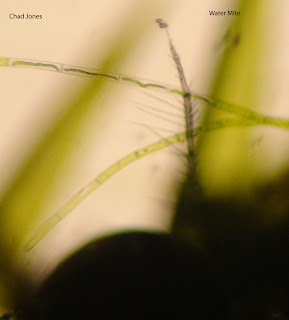Botany Term project
Monday, November 19, 2012
Final Observations
On 11/16/2012 the final observations of the microaquarium were made. This week I observed a great increase in the amount of algae colonies and paramecium. The number of microorganisms seems to have increased greatly. During my observations of the aquarium I noticed a few new creatures. These include 12 Nematodes, 1 Water Bear, a few hundred Paramecium, Two Epistylis, and about six Eupalotes. My speculation is the death of the water mite in my aquarium allowed the number of other microorganisms to greatly increase. The number of Rotifera were also greatly increased. I was unable to find the Amoeba within the aquarium, however, the verticella were readily observed as well. A few colonies of diatoms were noticed this week as well. This was perhaps the largest number of life forms that I was able to observe making this perhaps the most interesting week of observations of the microaquarium.
Monday, November 12, 2012
Week 3 Observations.
On 11/09/12 the micro-aquarium had multiple different lifeforms that I did not notice before. Verticella sp was one of the primary ones that I noticed in multiple locations. As I was searching along throughout the aquarium, I noticed a small mass that seemed to be moving down the aquarium. As I watched this form changed shapes quite a few times. The amoeba was a very interesting thing to see in the aquarium, having never seen one before not in a book.
One of the biggest changes I noticed this week, was the water mite was deceased. As I watched it closely, some euchlanis rotifera seemed to come in at apparently eat portions of it. There was a greater number of rotifera this week compared to prior weeks. I did not see any of the tachyasoma.
One of the biggest changes I noticed this week, was the water mite was deceased. As I watched it closely, some euchlanis rotifera seemed to come in at apparently eat portions of it. There was a greater number of rotifera this week compared to prior weeks. I did not see any of the tachyasoma.
Monday, November 5, 2012
Week Two Observations
The second week of observations has shown a great increase in the activity. With the addition of "Atison's Betta Food" made by Ocean Nutrition, Aqua Pet Americas, 3528 West 500 South, Salt Lake City, UT 84104. Ingredients: Fish meal, wheat flower, soy meal, krill meal, minerals, vitamins and preservatives. Analysis: Crude Protein 36%; Crude fat 4.5%; Crude Fiber 3.5%; Moisture 8% and Ash 15%, done on Friday the 26th of October, 2012 seems to have caused the many different creatures to be more active and a greater number of Rotifera were seen. The primary one that was seen and identified with the help of Kenneth McFarland was the Euchlanis Rotifera. This creature had a round body, single tail, and a small head. Perhaps fifteen of these were readily observed.
Tuesday, October 23, 2012
First Week Observations of a Microaquarium
 The observations on October 23, 2012 were much more interesting than the previous week. Within the aquarium was observed three rodifers, one spyrogyra, and multiple tachysoma. The water mite was especially active and avoided the light of the microscope. The rotifera were perhaps the most interesting of the single celled organisms within the aquarium as it appeared that they were slowly chewing away at the leaves of both plants within. The tachysoma had the appearance of small worms that seemed to be burrowing through the plant leaves.
The observations on October 23, 2012 were much more interesting than the previous week. Within the aquarium was observed three rodifers, one spyrogyra, and multiple tachysoma. The water mite was especially active and avoided the light of the microscope. The rotifera were perhaps the most interesting of the single celled organisms within the aquarium as it appeared that they were slowly chewing away at the leaves of both plants within. The tachysoma had the appearance of small worms that seemed to be burrowing through the plant leaves. Building of a Microaquarium
The water used in this project came from container 12. This water was collected from the water pool below Fountain City Park, west of Broadway at Hotel Avenue in Knoxville, Tn, Knox Co. This is a spring fed pond with full shade exposure. The latitude and longitude of the pool is N 36'02.235" W 83'55.986" at 990 ft above sea level. The plants that were added are Amblestegium and Utricularia gibba. The water and plants were placed within a 2" x 4" plastic micro aquarium, thus allowing us to observe the activity within the container. First observations there was very little activity within the container. A single water mite was able to be identified within the aquarium. No other microscopic organisms were observed during this viewing.
Bibliography
Patterson, D.J. 1996 Free Living Freshwater Protozoa Washington D.C. Manson Publishing
Pennak, Robert W. 1989 Fresh Water Invertebrates of the United States: Protozoa to Mollusca 3rd Edition. John Wiley & Sons, Inc. New York(NY)
Pennak, Robert W. 1989 Fresh Water Invertebrates of the United States: Protozoa to Mollusca 3rd Edition. John Wiley & Sons, Inc. New York(NY)
Subscribe to:
Comments (Atom)









